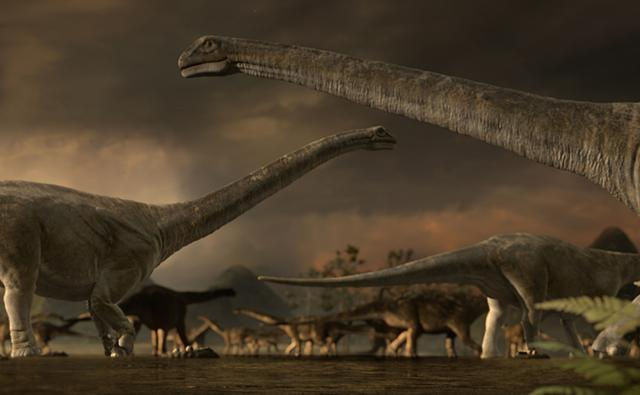
CREATURE-PEDIA
Argentinosaurus




Argentinosaurus (meaning "Argentine lizard") is a titanosaur sauropod dinosaur first discovered by Guillermo Heredia in Argentina. The generic name refers to the country in which it was discovered. The dinosaur lived on the then-island continent of South America somewhere between 94 and 97 million years ago, during the Late Cretaceous Period. It is among the largest known dinosaurs. Standing over 3 stories tall, a 6ft person wouldn’t even reach the knee of an Argentinosaurus, at up to 90 tons, it likely weighed as much as 11 T-Rexes and at 130 feet long from head to tail, it was the length of a space shuttle orbiter. The scattered remains of Argentinosaurus are "associated" with those of the 10-ton carnivore Giganotosaurus, meaning these two dinosaurs shared the same territory. While there's no way even a desperate Giganotosaurus could have taken down a full-grown Argentinosaurus all by itself, it's possible that these large theropods hunted in packs, thus leveling the odds. Because of physical and biological constraints, there's an upper limit to how large any given dinosaur egg can be--and considering its huge size, Argentinosaurus probably brushed up against that limit. Based on comparisons with the eggs of other titanosaurs (such as the eponymous genus Titanosaurus), it seems likely that Argentinosaurus eggs didn't exceed a foot in diameter, and females laid up to 10 or 15 eggs at a time--increasing the odds that at least one hatchling would survive into adulthood. There's still a lot we don't know about the growth rates of plant-eating dinosaurs like sauropods and titanosaurs; most likely, juveniles reached maturity at a much slower pace than that of warm-blooded theropods. Given the ultimate heft of Argentinosaurus, it's not inconceivable that a newborn hatchling took three or four decades to reach full adulthood, that would represent (depending on the model you use) about a 25,000 percent increase in size from hatchling to herd alpha! Argentinosaurus was an herbivore, it probably used its long neck to reach into conifers, or sweep the ground in search of ferns and bushes. Once swallowed, the food would have needed to travel all the way down the neck before entering the stomach. Inside the stomach, the vegetation would have been ground or broken down by smooth stones known as gastroliths. Argentinosaurus was a herbivore that fed in the treetops with its great size and long neck that also allowed it to avoid competition with smaller herbivores. Just like other titanosaurs, argentinosaurus had a head the size of a horse because it didn’t chew its food, it just grabbed and swallow, the skull is basically a plant vacuum they didn’t had the ability to chew. What that means is that Argentinosaurus had the capacity to consume over 2 tons of vegetation every day and that’s how these beasts grow to gigantic size. The answer to a question (Did Argentinosaurus hold its neck vertically, the better to nibble the leaves of tall trees, or did it forage in a more horizontal posture?) is still a mystery, not only for Argentinosaurus, but for pretty much all long-necked sauropods and titanosaurs. The difficulty is that a vertical posture would have placed enormous demands on this hundred-ton herbivore's heart (imagine having to pump blood 40 feet into the air!), given our current state of knowledge about Argentinosaurus' physiology.
Fun Fact
When Argentinosaurus was fully grown, they had no predator that can killer.

